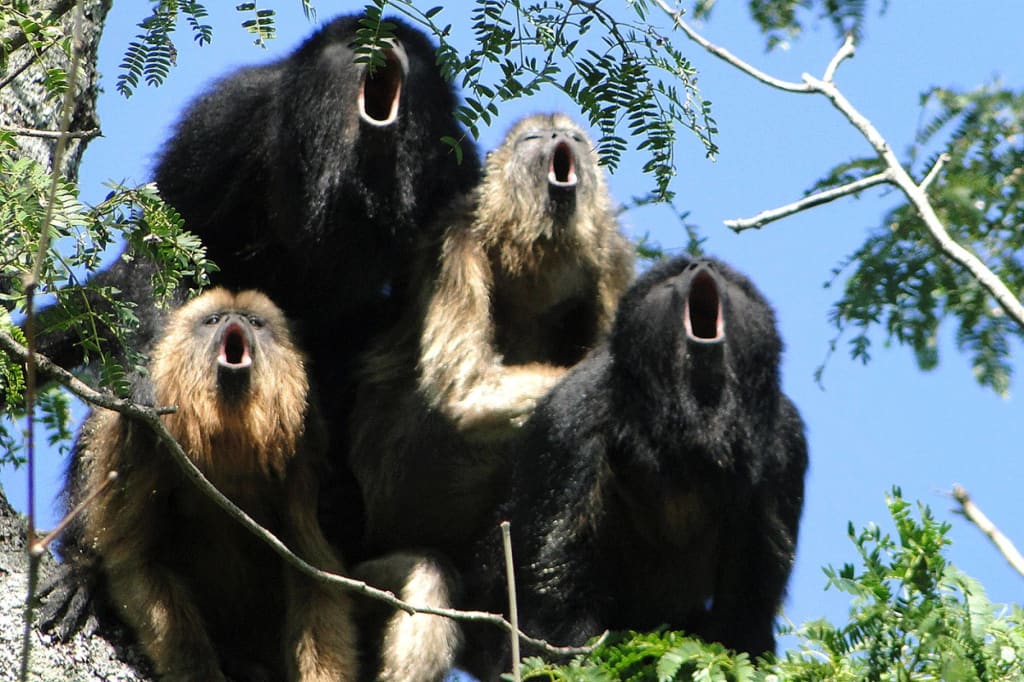Nature's Alarm Clock. .The Howler Monkeys of Costa Rica!
If you don't like "EARLY", then stay far away from the jungles of Costa Rica! If you do enjoy getting up before dawn, then you've now found your paradise!

When I was growing up and in elementary school, I had my trusty, windup alarm clock right by my bedside. . about six inches from my left ear! This thing was huge. It was the kind that had a lot of chrome on it. The bell was situated on the top of the clock base. . and when it was time, two big hammers on either side of the bell started dancing the Watusi! There was NO WAY that I was sleeping through that sound. From K through 12, I was NEVER late for school.
When I spend time at one of the many lodges/getaways in the Southern Zone of Costa Rica, there's no need for any kind of alarm clock. We just wait for the howler monkeys to work their magic. Nature's little nudge. . it's time to start your day. Well, it's not really a 'nudge'. . it's BREAKING NEWS! It's an ANNOUNCEMENT on STERIODS!
Howler Monkeys are duly named for their throaty howls that can be heard for up to 3 1/2 miles. They are the loudest of all New World monkeys. There are 9 species of howler monkeys and Costa Rica is the home to the common, "mantled howler", which is found in many parts of Southern Mexico, Central and South America.
Mantled howler monkeys, called "mono congos" here in Costa Rica, can weigh up to 22 pounds and usually have black fur. But once in a while, you'll spot one with brown fur. Some have a brown or golden mantle that is formed by long hairs along their sides and their backs. Their very long, prehensile tails serves just like an extra arm, allowing them to hang on to and grip branches while they move all around the rainforest canopy in search of food. They have huge appetites and take their intake of food seriously! They are eat lots of leaves and also feed on flowers and fruit. They spend most of their time in the treetops, foraging for food. They don't spend too much time at all of the ground. That is where their predators are. Big cats especially love to hunt these animals. Snakes are a threat as well. Howler monkeys are the largest of all New World monkeys and have a lifespan of up to 15 years.
Mantled howler monkeys can be found in the high canopies of both lowland and mountain rainforests. They are usually heard long before they are seen. A troop of howler monkeys usually consists of up to 15 females, three or four dominant males and several youngsters. In Costa Rica, howler monkey sightings are common as they inhabit many of the country’s national parks and reserves, including Corcovado National Park in the south, the dry forests of Santa Rosa National Park, Arenal Volcano National Park and the Monteverde Cloud Forest Reserve in the northern area of Costa Rica.
Females breed once every 2 years or so and typically give birth to 1 offspring after 6 months. With a year-round breeding season, males mate with several females and females mate with many males. An infant howler will cling to its mother’s belly for a month or so and then catch a ride on her back. Mothers nurse their young for up to 1 year and have been known to care for abandoned or injured howler babies as well.
The mantled howler monkey is protected by the Convention on International Trade in Endangered Species (CITES) Program, which prevents international trading of the species. While their population is not considered threatened, the biggest concern is the serious destruction of their native habitat. Recently, this has pushed the monkeys into human territory, such as cacao (chocolate) and coffee plantations. Howler monkeys play an important role by spreading flower and plant seeds in their dung, which aids in continuous rainforest habitat regeneration. Mother nature has a way to keep everything going. . forever! And that is why you hear so much about the preservation of the hundreds of thousands of animal species here in Costa Rica. The government has protected over 25% of the land here. . they are very serious about their flora and fauna!
Every child in Costa Rica (and a lot of drunken adults!) learns how to perfectly imitate the sounds of the howler. It’s a tradition. And while howlers are not aggressive, they definitely sound like they are! The thunderous males call out to each other every morning with a guttural sound, more similar to a lion’s roar than the calls of a small, tree-dwelling, leaf-eating monkey. The spine-tingling cries can carry as far as 3 1/2 miles in even the densest of jungles. They call out once more at dusk and will also howl if a trespasser comes too close as a way of warning other monkeys belonging to other troops to stay their distance.
Their powerful howls are produced by their very large larynx and long throat, both which expand outward, inflating and then resonating. Females have loud wails and groans that signal distressed situations or for calling a lost infant.
Costa Rica is full of fascinating creatures. Be sure to search for more information on the Howler Monkey before you visit Costa Rica and try to spot one in the flesh! You'll be glad you had a chance to hear their howl and also to experience all that Costa Rica has to offer!
You're invited to visit our websites at: www.costaricagoodnewsreport.com & www.costaricaimmigrationandmovingexperts.com
Also, please enjoy our over 1,700 episodes of our "Costa Rica Pura Vida Lifestyle Podcast Series". We are found on all major podcast venues, including iHeartRADIO, Spotify, Apple Podcasts, Google Podcasts, Radio FM, Anchor & many more. Here's our link: www.anchor.fm/costa-rica-pura-vida
About the Creator
William "Skip" Licht
Costa Rica is a magical place. Since November, 2002, when I first visited this country, I have been in love with the people, the culture, its biodiversity, the food. . everything about it makes me happy! Now I share my excitement with you!






Comments
There are no comments for this story
Be the first to respond and start the conversation.